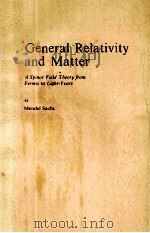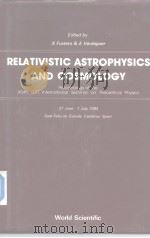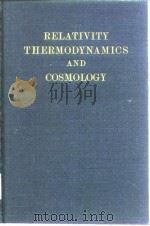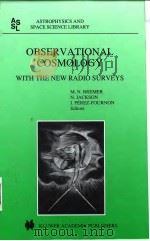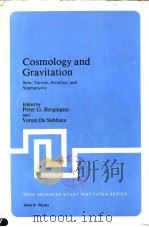《Relativity Thermodynamics and Cosmology》
| 作者 | Richard C.Tolman 编者 |
|---|---|
| 出版 | 未查询到或未知 |
| 参考页数 | 502 |
| 出版时间 | 没有确切时间的资料 目录预览 |
| ISBN号 | 无 — 求助条款 |
| PDF编号 | 819751578(仅供预览,未存储实际文件) |
| 求助格式 | 扫描PDF(若分多册发行,每次仅能受理1册) |
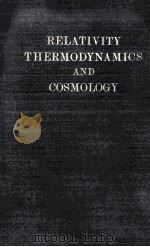
Ⅰ.INTRODUCTION1
1.The Subject-Matter1
2.The Method of Presentation7
3.The Point of View9
Ⅱ.THE SPECIAL THEORY OF RELATIVITY12
Part Ⅰ.THE TWO POSTULATES AND THE LORENTZ TRANSFORMATION12
4.Introduction12
5.The First Postulate of Relativity12
6.The Second Postulate of Relativity15
7.Necessity for Modifying Older Ideas as to Space and Time17
8.The Lorentz Transformation Equations18
9.Transformation Equations for Spatial and Temporal Intervals Lorentz Contraction and Time Dilation22
10.Transformation Equations for Velocity25
11.Transformation Equation for the Lorentz Contraction Factor27
12.Transformation Equations for Acceleration27
Part Ⅱ.TREATMENT OF SPECIAL RELATIVITY WITH THE HELP OF A FOUR-DIMENSIONAL GEOMETRY28
13.The Space-Time Continuum28
14.The Three Plus One Dimensions of Space-Time29
15.The Geometry Corresponding to Space-Time30
16.The Signature of the Line Element and the Three Kinds of Interval31
17.The Lorentz Rotation of Axes32
18.The Transformation to Proper Coordinates33
19.Use of Tensor Analysis in the Theory of Relativity34
20.Simplification of Tensor Analysis in the Case of Special Relativity Galilean Coordinates37
21.Correspondence of Four-Dimensional Treatment with the Postulates of Special Relativity39
Ⅲ.SPECIAL RELATIVITY AND MECHANICS42
Part Ⅰ.THE DYNAMICS OF A PARTICLE42
22.The Principles of the Conservation of Mass and Momentum42
23.The Mass of a Moving Particle43
24.The Transformation Equations for Mass45
25.The Definition and Transformation Equations for Force45
26.Work and Kinetic Energy47
27.The Relations between Mass,Energy,and Momentum48
28.Four-Dimensional Expression of the Mechanics of a Particle50
29.Applications of the Dynamics of a Particle53
(a)The Mass of High-Velocity Electrons53
(b) The Relation between Force and Acceleration54
(c) Applications in Electromagnetic Theory55
(d) Tests of the Interrelation of Mass,Energy,and Momentum57
Part Ⅱ.THE DYNAMICS OF A CONTINUOUS MECHANICAL MEDIUM59
30.The Principles Postulated59
31.The Conservation of Momentum and the Components of Stress tij60
32.The Equations of Motion in Terms of the Stresses tij60
33.The Equation of Continuity62
34.The Transformation Equations for the Stresses tij62
35.The Transformation Equations for the Densities of Mass and Momentum65
36.Restatement of Results in Terms of the (Absolute) Stresses pij69
37.Four-Dimensional Expression of the Mechanics of a Continuous Medium70
38.Applications of the Mechanics of a Continuous Medium73
(a)The Mass and Momentum of a Finite System74
(b) The Angular Momentum of a Finite System77
(c) The Right-Angled Lever as an Example79
(d) The Complete Static System80
Ⅳ.SPECIAL RELATIVITY AND ELECTRODYNAMICS84
Part Ⅰ.ELECTRON THEORY84
39.The Maxwell-Lorentz Field Equations84
40.The Transformation Equations for E,H,and ρ86
41.The Force on a Moving Charge88
42.The Energy and Momentum of the Electromagnetic Field89
43.The Electromagnetic Stresses91
44.Transformation Equations for Electromagnetic Densities and Stresses92
45.Combined Result of Mechanical and Electromagnetic Actions93
46.Four-Dimensional Expression of the Electron Theory95
(a)The Field Equations95
(b) Four-Dimensional Expression of Force on Moving Charge98
(c) Four-Dimensional Expression of Electromagnetic Energy-Momentum Tensor99
47.Applications of the Electron Theory99
Part Ⅱ.MACROSCOPIC THEORY101
48.The Field Equations for Stationary Matter101
49.The Constitutive Equations for Stationary Matter102
50.The Field Equations in Four-Dimensional Language102
51.The Constitutive Equations in Four-Dimensional Language104
52.The Field Equations for Moving Matter in Ordinary Vector Language105
53.The Constitutive Equations for Moving Matter in Ordinary Vector Language108
54.Applications of the Macroscopic Theory109
(a)The Conservation of Electric Charge109
(b) Boundary Conditions110
(c) The Joule Heating Effect112
(d) Electromagnetic Energy and Momentum113
(e) The Energy-Momentum Tensor115
(f) Applications to Experimental Observations116
Ⅴ.SPECIAL RELATIVITY AND THERMODYNAMICS118
Part Ⅰ.THE THERMODYNAMICS OF STATIONARY SYSTEMS118
55.Introduction118
56.The First Law of Thermodynamics and the Zero Point of Energy Content120
57.The Second Law of Thermodynamics and the Starting-Point for Entropy Content121
58.Heat Content,Free Energy,and Thermodynamic Potential123
59.General Conditions for Thermodynamic Change and Equilibrium125
60.Conditions for Change and Equilibrium in Homogeneous Systems127
61.Uniformity of Temperature at Thermal Equilibrium130
62.Irreversibility and Rate of Change132
63.Final State of an Isolated System134
64.Energy and Entropy of a Perfect Monatomic Gas136
65.Energy and Entropy of Black-Body Radiation139
66.The Equilibrium between Hydrogen and Helium140
67.The Equilibrium between Matter and Radiation146
Part Ⅱ.THE THERMODYNAMICS OF MOVING SYSTEMS152
68.The Two Laws of Thermodynamics for a Moving System152
69.The Lorentz Transformation for Thermodynamic Quantities153
(a)Volume and Pressure153
(b) Energy154
(c) Work156
(d) Heat156
(e) Entropy157
(f) Temperature158
70.Thermodynamic Applications159
(a)Carnot Cycle Involving Change in Velocity159
(b) The Dynamics of Thermal Radiation161
71.Use of Four-Dimensional Language in Thermodynamics162
Ⅵ.THE GENERAL THEORY OF RELATIVITY165
Part Ⅰ.THE FUNDAMENTAL PRINCIPLES OF GENERAL RELATIVITY165
72.Introduction165
73.The Principle of Covariance166
(a)Justification for the Principle of Covariance166
(b) Consequences of the Principle of Covariance167
(c) Method of Obtaining Covariant Expressions168
(d) Covariant Expression for Interval169
(e) Covariant Expression for the Trajectories of Free Particles and Light Rays171
74.The Principle of Equivalence174
(a)Formulation of the Principle of Equivalence.Metric and Gravitation174
(b) Principle of Equivalence and Relativity of Motion176
(c) Justification for the Principle of Equivalence179
(d) Use of the Principle of Equivalence in Generalizing the Principles of Special Relativity.Natural and Proper Coordinates180
(e) Interval and Trajectory in the Presence of Gravitational Fields181
75.The Dependence of Gravitational Field and Metric on the Distribution of Matter and Energy.Principle of Mach184
76.The Field Corresponding to the Special Theory of Relativity.The Riemann-Christoffel Tensor185
77.The Gravitational Field in Empty Space.The Contracted Riemann-Christoffel Tensor187
78.The Gravitational Field in the Presence of Matter and Energy188
Part Ⅱ.ELEMENTARY APPLICATIONS OF GENERAL RELATIVITY192
79.Simple Consequences of the Principle of Equivalence192
(a)The Proportionality of Weight and Mass192
(b) Effect of Gravitational Potential on the Rate of a Clock192
(c) The Clock Paradox194
80.Newton's Theory as a First Approximation198
(a)Motion of Free Particle in a Weak Gravitational Field198
(b) Poisson's Equation as an Approximation for Einstein's Field Equations199
81.Units to be Used in Relativistic Calculations201
82.The Schwarzschild Line Element202
83.The Three Crucial Tests of Relativity205
(a)The Advance of Perihelion208
(b) The Gravitational Deflexion of Light209
(c) Gravitational Shift in Spectral Lines211
Ⅶ.RELATIVISTIC MECHANICS214
Part Ⅰ.SOME GENERAL MECHANICAL PRINCIPLES214
84.The Fundamental Equations of Relativistic Mechanics214
85.The Nature of the Energy-Momentum Tensor.General Expression in the Case of a Perfect Fluid215
86.The Mechanical Behaviour of a Perfect Fluid218
87.Re-expression of the Equations of Mechanics in the Form of an Ordinary Divergence222
88.The Energy-Momentum Principle for Finite Systems225
89.The Densities of Energy and Momentum Expressed as Divergences229
90.Limiting Values for Certain Quantities at a Large Distance from an Isolated System230
91.The Mass,Energy and Momentum of an Isolated System232
92.The Energy of a Quasi-Static Isolated System Expressed by an Integral Extending Only Over the Occupied Space234
Part Ⅱ.SOLUTIONS OF THE FIELD EQUATIONS236
93.Einstein's General Solution of the Field Equations in the Case of Weak Fields236
94.Line Elements for Systems with Spherical Symmetry239
95.Static Line Element with Spherical Symmetry241
96.Schwarzschild's Exterior and Interior Solutions245
97.The Energy of a Sphere of Perfect Fluid247
98.Non-Static Line Elements with Spherical Symmetry250
99.Birkhoff's Theorem252
100.A More General Line Element253
Ⅷ.RELATIVISTIC ELECTRODYNAMICS258
Part Ⅰ.THE COVARIANT GENERALIZATION OF ELECTRICAL THEORY258
101.Introduction258
102.The Generalized Lorentz Electron Theory.The Field Equations258
103.The Motion of a Charged Particle259
104.The Energy-Momentum Tensor261
105.The Generalized Macroscopic Theory261
Part Ⅱ.SOME APPLICATIONS OF RELATIVISTIC ELECTRODYNAMICS264
106.The Conservation of Electric Charge264
107.The Gravitational Field of a Charged Particle265
108.The Propagation of Electromagnetic Waves267
109.The Energy-Momentum Tensor for Disordered Radiation269
110.The Gravitational Mass of Disordered Radiation271
111.The Energy-Momentum Tensor Corresponding to a Directed Flow of Radiation272
112.The Gravitational Field Corresponding to a Directed Flow of Radiation273
113.The Gravitational Action of a Pencil of Light274
(a)The Line Element in the Neighbourhood of a Limited Pencil of Light274
(b) Velocity of a Test Ray of Light in the Neighbourhood of the Pencil275
(c) Acceleration of a Test Particle in the Neighbourhood of the Pencil277
114.The Gravitational Action of a Pulse of Light279
(a)The Line Element in the Neighbourhood of the Limited Track of a Pulse of Light279
(b) Velocity of a Test Ray of Light in the Neighbourhood of the Pulse281
(c) Acceleration of a Test Particle in the Neighbourhood of the Pulse282
115.Discussion of the Gravitational Interaction of Light Rays and Particles285
116.The Ceneralized Doppler Effect288
Ⅸ.RELATIVISTIC THERMODYNAMICS291
Part Ⅰ.THE EXTENSION OF THERMODYNAMICS TO GENERAL RELATIVITY291
117.Introduction291
118.The Relativistic Analogue of the First Law of Thermodynamics292
119.The Relativistic Analogue of the Second Law of Thermodynamics293
120.On the Interpretation of the Relativistic Second Law of Thermodynamics296
121.On the Interpretation of Heat in Relativistic Thermodynamics297
122.On the Use of Co-Moving Coordinates in Thermodynamic Considerations301
Part Ⅱ.APPLICATIONS OF RELATIVISTIC THERMODYNAMICS304
123.Application of the First Law to Changes in the Static State of a System304
124.Application of the Second Law to Changes in the Static State of a System306
125.The Conditions for Static Thermodynamic Equilibrium307
126.Static Equilibrium in the Case of a Spherical Distribution of Fluid308
127.Chemical Equilibrium in a Gravitating Sphere of Fluid311
128.Thermal Equilibrium in a Gravitating Sphere of Fluid312
129.Thermal Equilibrium in a General Static Field315
130.On the Increased Possibility in Relativistic Thermodynamics for Reversible Processes at a Finite Rate319
131.On the Possibility for Irreversible Processes without Reaching a Final State of Maximum Entropy326
132.Conclusion330
Ⅹ.APPLICATIONS TO COSMOLOGY331
Part Ⅰ.STATIC COSMOLOGICAL MODELS331
133.Introduction331
134.The Three Possibilities for a Homogeneous Static Universe333
135.The Einstein Line Element335
136.The de Sitter Line Element335
137.The Special Relativity Line Element336
138.The Geometry of the Einstein Universe337
139.Density and Pressure of Material in the Einstein Universe339
140.Behaviour of Particles and Light Rays in the Einstein Universe341
141.Comparison of Einstein Model with Actual Universe344
142.The Geometry of the de Sitter Universe346
143.Absence of Matter and Radiation from the de Sitter Universe348
144.Behaviour of Test Particles and Light Rays in the de Sitter Universe349
(a)The Geodesic Equations349
(b) Orbits of Particles351
(c) Behaviour of Light Rays in the de Sitter Universe353
(d) Doppler Effect in the de Sitter Universe354
145.Comparison of de Sitter Model with Actual Universe359
Part Ⅱ.THE APPLICATION OF RELATIVISTIC MECHANICS TO NON-STATIC HOMOGENEOUS COSMOLOGICAL MODELS361
146.Reasons for Changing to Non-Static Models361
147.Assumption Employed in Deriving Non-Static Line Element362
148.Derivation of Line Element from Assumption of Spatial Isotropy364
149.General Properties of the Line Element370
(a)Different Forms of Expression for the Line Element370
(b) Geometry Corresponding to Line Element371
(c) Result of Transfer of Origin of Coordinates372
(d) Physical Interpretation of Line Element375
150.Density and Pressure in Non-Static Universe376
151.Change in Energy with Time379
152.Change in Matter with Time381
153.Behaviour of Particles in the MOdel383
154.Behaviour of Light Rays in the Model387
155.The Doppler Effect in the Model389
156.Change in Doppler Effect with Distance392
157.General Discussion of Dependence on Time for Closed Models394
(a)General Features of Time Dependence,R real,ρ00 ? 0,p0 ? 0395
(b) Curve for the Critical Function of R396
(c) Monotonic Universes of Type M1,for ? > ?E399
(d) Asymptotic Universes of Types A1 and A2,for ? = ?E400
(e) Monotonic Universes of Type M2 and Oscillating Universes of Types O1 and O2,for 0 < ? < ?E401
(f) Oscillating Universes of Type O1,for ? 0402
158.General Discussion of Dependence on Time for Open Models403
159.On the Instability of the Einstein Static Universe405
160.Models in Which the Amount of Matter is Constant407
161.Models Which Expand from an Original Static State409
162.Ever Expanding Models Which do not Start from a Static State412
163.Oscillating Models (? = 0)412
164.The Open Model of Einstein and de Sitter (? = 0,R0 = ?)415
165.Discussion of Factors which were Neglected in Studying Special Models416
Part Ⅲ.THE APPLICATION OF RELATIVISTIC THERMODYNAMICS TO NON-STATIC HOMOGENEOUS COSMOLOGICAL MODELS420
166.Application of the Relativistic First Law420
167.Application of the Relativistic Second Law421
168.The Conditions for Thermodynamic Equilibrium in a Static Einstein Universe423
169.The Conditions for Reversible and Irreversible Changes in Non-Static Models424
170.Model Filled with Incoherent Matter Exerting No Pressure as an Example of Reversible Behaviour426
171.Model Filled with Black-Body Radiation as an Example of Reversible Behaviour427
172.Discussion of Failure to Obtain Periodic Motions without Singular States429
173.Interpretation of Reversible Expansions by an Ordinary Observer432
174.Analytical Treatment of a Succession of Expansions and Contractions for a Closed Model with ? = 0435
(a)The Upper Boundary of Expansion436
(b) Time Necessary to Reach Maximum436
(c) Time Necessary to Complete Contraction437
(d) Behaviour at Lower Limit of Contraction438
175.Application of Thermodynamics to a Succession of Irreversible Expansions and Contractions439
Part Ⅳ.CORRELATION OF PHENOMENA IN THE ACTUAL UNIVERSE WITH THE HELP OF NON-STATIC HOMOGENEOUS MODELS445
176.Introduction445
177.The Observational Data446
(a)The Absolute Magnitudes of the Nearer Nebulae446
(b) The Corrected Apparent Magnitudes for more Distant Nebulae448
(c) Nebular Distances Calculated from Apparent Magnitudes453
(d) Relation of Observed Red-Shift to Magnitude and Distance454
(e) Relation of Apparent Diameter to Magnitude and Distance457
(f) Actual Diameters and Masses of Nebulae458
(g) Distribution of Nebulae in Space459
(h) Density of Matter in Space461
178.The Relation between Coordinate Position and Luminosity462
179.The Relation between Coordinate Position and Astronomically Determined Distance465
180.The Relation between Coordinate Position and Apparent Diameter467
181.The Relation between Coordinate Position and Counts of Nebular Distribution468
182.The Relation between Coordinate Position and Red-shift469
183.The Relation of Density to Spatial Curvature and Cosmological Constant473
184.The Relation between Red-shift and Rate of Disappearance of Matter475
185.Summary of Correspondences between Model and Actual Universe478
186.Some General Remarks Concerning Cosmological Models482
(a)Homogeneity482
(b) Spatial Curvature483
(c) Temporal Behaviour484
187.Our Neighbourhood as a Sample of the Universe as a Whole486
Appendix Ⅰ.SYMBOLS FOR QUANTITIES489
Scalar Quantities489
Vector Quantities490
Tensors490
Tensor Densities491
Appendix Ⅱ.SOME FORMULAE OF VECTOR ANALYSIS491
Appendix Ⅲ.SOME FORMULAE OF TENSOR ANALYSIS493
(a)General Notation493
(b) The Fundamental Metrical Tensor and its Properties494
(c) Tensor Manipulations495
(d) Miscellaneous Formulae496
(e) Formulae Involving Tensor Densities496
(f) Four-Dimensional Volume.Proper Spatial Volume496
Appendix Ⅳ.USEFUL CONSTANTS497
Subject Index499
Name Index502
《Relativity Thermodynamics and Cosmology》由于是年代较久的资料都绝版了,几乎不可能购买到实物。如果大家为了学习确实需要,可向博主求助其电子版PDF文件。对合法合规的求助,我会当即受理并将下载地址发送给你。
高度相关资料
-

- TIME AND THERMODYNAMICS
- 1947 OXFORD UNIVERSITY PRESS
-
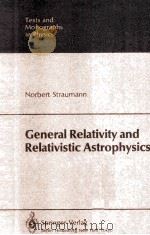
- General Relativity and Relativistic Astrophysics
- 1984 Springer-Verlag
-
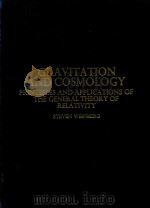
- GRAVITATION AND COSMOLOGY: PRINCIPLES AND APPLICATIONS OF THE GENERAL THEORY OF RELATIVITY
- 1972 JOHN WILEY & SONS
-
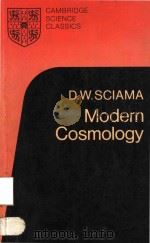
- Modern Cosmology
- 1971 The University of Chicago Press
-
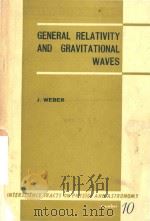
- General Relativity and Gravitational Waves
- 1961 Interscience Tracts on Physics and Astronomy
-
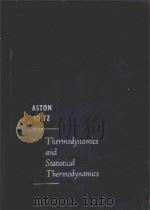
- THERMODYNAMICS AND STATISTICAL THERMODYNAMICS
- 1959 NEW YORK·JOHN WILEY & SONS,INC.
-

- General Relativity and Cosmology
- 1978 THE MACMILLAN PRESS LTD
-
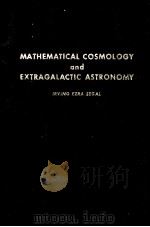
- MATHEMATICAL COSMOLOGY AND EXTRAGALACTIC ASTRONOMY
- 1976 ACADEMIC PRESS
提示:百度云已更名为百度网盘(百度盘),天翼云盘、微盘下载地址……暂未提供。➥ PDF文字可复制化或转WORD
